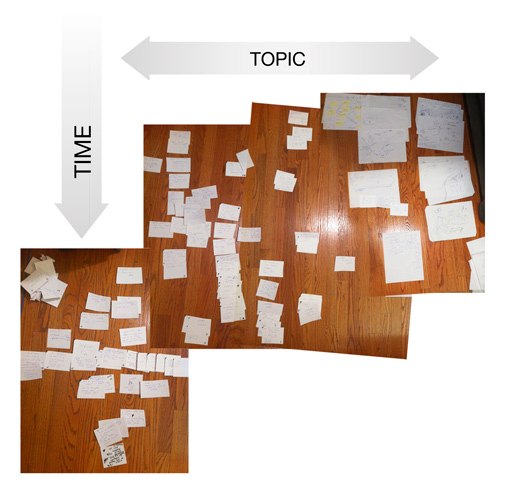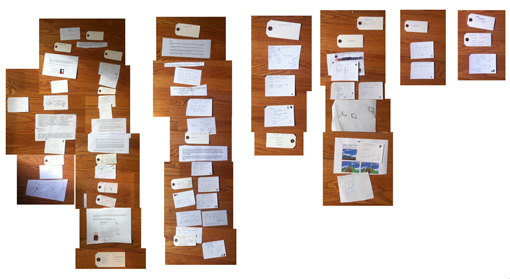Cards & Combinations
Posted on April 19, 2011 | posted by:For my project, I did not set out with a clear research plan. Instead, I conducted research using various methodologies based on need, including modified versions of a visual audit, grounded theory, literature review, and one iteration of a rapid prototype as part of a larger group and a separate project.
The most fruitful method was creating a card sorting exercise, a method borrowed from information architecture. I started with an exploration of my Evernote archive using keywords as a way to synthesize a trail of connections and refresh my memory. The information spanned a diverse landscape of sources and forms. This is the first way this exercise deviated from traditional cart sorting techniques, as I included a hybrid of information:
– Notes on lectures
– Critical events and observations within my own research
– My commentary on these notes, as well as others in the class
– Articles, essays or papers that I tagged as relevant to the subject
– Videos of precedent
– Audio recording of interviews with people related to the subject
– Results of paper and process prototypes
I summarized whatever information I found which had potential onto index card. After compiling a set of roughly 100 cards, I began to lay them out on the floor on two axes, vertically for time, and horizontally for associations – connections of meaning or relevance. This was the second way it deviated from traditional card sorting, and began to hint at potential for a system of sorting that could benefit from belonging in 3D space.

Through this process of sorting and mapping, I was able to begin to conceptualize the bigger picture of how my thought process had evolved over time, how my methodologies have changed, and of course, the current state of the idea. It also confirmed a few critical points:
1) Simultaneous research and publishing feed each other in a snowball effect. As responses often result in new leads.
2) Interdisciplinary thinking is critical. Many of the ideas I formed were born out of seemingly unrelated tangents, conversations and interests in other fields. The ability to record those and keyword them helped link them at a later time, and reinforces : ‘keep an eye out for interesting material that may be used later, even if you don’t know how they can right now.’
3) Having a stack of cards in physical form led to specific insights, connections and new developments. I was able to carry these during time spent commuting. Flipping through small cards with tidbits of these ideas, quotes, notes and drawings acted as an instant idea engine whenever I felt I had forgotten the current state, or was unmotivated. The challenge however was creating new cards, finding their place, and having to spatially recreating the map whenever resuming work, which became cumbersome and time consuming
After recording the time / association map through photos, I then shifted into a different mode: thinking of how to organize the same set of information in new ways. I began sorting the cards into groups without considering the order in any way, and quickly noticed a pattern: they were clustering as answers to basic questions: What, Where, Why, How.
I iterated many times over and over time began playing with the order of the cards and thinking more closely about a narrative through the connections between cards. For example, “This card results in this”. “This quote card supports this speculation card”. It was great use to have a fluid form, where the pieces could easily be rearranged and did no require writing to disrupt the flow. This resulted in many combinations of ordering, and after every few iterations, I run through the narrative with an out-loud test as an evaluation of flow. This was very similar to playing a song on a digital production suite after making a set of changes.
As the map got more refined, it slowly became the struts for a presentation, as I switched to creating a website presentation as a snapshot of my current state of research.
What these rudimentary paper sorting and categorization methods have shown me, is that often the combination and recombination of information can prove useful in developing new ideas. These ideas are new configurations of existing ideas, as Steven Johnson similarly claims in his new book, Where Good Ideas Comes From.
Ironically, these processes themselves acted as a topically related prototype of the what I was researching: how to build a system that allows groups working together in (multi • trans • inter) disciplinary teams can share their research findings and help formulate connections between them.
This entire stage served as a non-linear exploration, and I look forward to continue parallel tracks of research and production. Specifically, I intend on experimenting with different types of research as the project develops.

